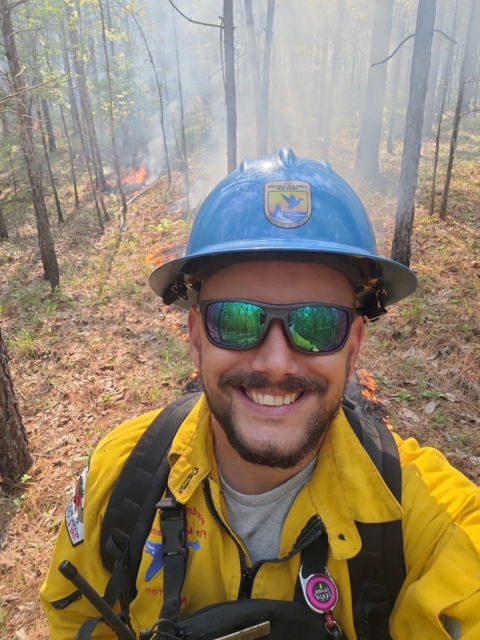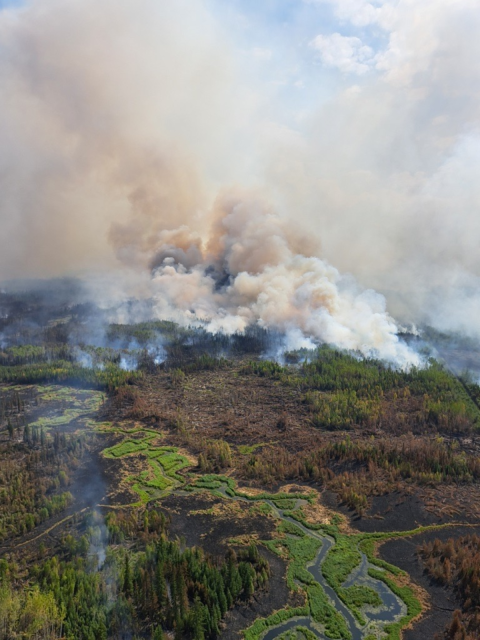Nathan Herron, Fire Management Specialist at Piedmont National Wildlife Refuge in Georgia, spent part of the wildfire season assisting wildfire suppression efforts in Canada. When you work in wildland fire, odds are you hold numerous qualifications that allow you to wear many hats. These qualifications can lead you to some out of the way places. One of the many hats Herron wears is as a division/group supervisor while out on wildfire assignments.
The division/group supervisor is responsible for all operations conducted in a designated area (division) on wildland fire incidents and helps prepare and mobilize individuals in the division. He or she also maintains accountability and communications between the field and command.
Joining the Southern Area Blue Team in Canada, Herron and the team were assigned to the Long Lake Fire (HWF-036) in Alberta and the Paskwa Fire (HWF-003) in British Columbia. With these two fires, the team was responsible for 680,000 acres of wildfire.
For Herron the first part of the day was spent hopping from one fire crew’s location to the next to check in and ensure clarity of mission and assignment and to answer any questions. During this time, he also checked to make sure fire activity, firelines, and fire perimeter were up to date on the maps and other reports.
Afternoon typically consisted of reconnaissance flights in a helicopter checking for fire movement and overall fire behavior and checking in with the on-the-ground fire crews again. At the end of the day, Herron made sure all personnel made it off the line safely.
“A big part of my job is maintaining that big-picture view of the fire,” said Herron, “which better maintains a safe work environment and ensures fire crews are completing the objectives. “
Fire activity around the Rainbow Lake area in Alberta consisted mostly of ground fire. With ground fire, visible flames are minimal. Fire activity was mostly visible through smoke seeping up through the ground cover. However, this type of fire is just as dangerous as surface fire (burning in surface fuels such as litter, downed woody debris, and low-level living plants).
“Ground fires are typical on the east coast of the U.S.,” said Herron. “With ground fires, you will hardly ever see flames. You’ll just see smoke billowing up from under the ground and then trees and other vegetation will just start to fall over. Occasionally, the wind would pick up and pull the fire into the canopy and crowns of the trees, and the fire would spread until it hit a wet area and then would settle down again. There were areas in Canada where the fire burned 30 feet deep into the ground. While we were assigned to the fires, there were multiple days of very active fire with up to a quarter mile of spotting and crowning ([fire in forest canopy]). On these days, we would have up to eight helicopters flying fire operations at one time.”
Further reflecting on his time in Canada, Herron said the most difficult part of the assignment was wrapping his mind around the use of the metric system. Another challenge was learning new fire terminology. For instance, Canadians use the term crossover to describe atmospheric conditions that can produce extreme fire behavior. Crossover is reached when the air temperature reading (in Celsius) and relative humidity reading converge. These types of days in the United States would be referred to as high fire-danger days.
“I tried my best to learn all their terminology so I could speak the operational language while I was there,” said Herron. “The Canadians did everything they could to acknowledge that an international suppression effort was taking place. The least I could do was meet them on their own level.”
Overall, Herron describes his experience as a once-in-a-lifetime opportunity.
“There are so many good takeaways from this experience,” said Herron. “To have had this opportunity in my career and learn how another country fights fire was enlightening. When you work in a career for so long, you get used to the way you’ve always done things. To see different approaches and different perspectives will stick with me my entire life.”






